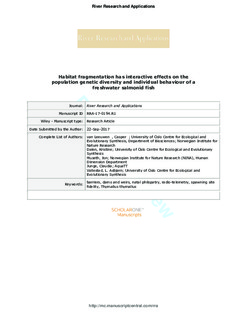| dc.contributor.author | van Leeuwen, Casper | |
| dc.contributor.author | Dalen, Kristine | |
| dc.contributor.author | Museth, Jon | |
| dc.contributor.author | Junge, Claudia | |
| dc.contributor.author | Vøllestad, Leif Asbjørn | |
| dc.coverage.spatial | Sout-eastern Norway, sør-øst Norge | nb_NO |
| dc.date.accessioned | 2017-11-10T11:20:03Z | |
| dc.date.available | 2017-11-10T11:20:03Z | |
| dc.date.created | 2017-10-31T20:57:51Z | |
| dc.date.issued | 2017 | |
| dc.identifier.issn | 1535-1459 | |
| dc.identifier.uri | http://hdl.handle.net/11250/2465521 | |
| dc.description.abstract | Sufficient genetic diversity can aid populations to persist in dynamic and fragmented environments. Understanding which mechanisms regulate genetic diversity of riverine fish can therefore advance current conservation strategies. The aim of this study was to investigate how habitat fragmentation interacted with population genetic diversity and individual behaviour of freshwater fish in large river systems. We studied a population of the long‐distance migratory, iteroparous freshwater salmonid European grayling (Thymallus thymallus) in south‐eastern Norway. Genotyping (n = 527) and radio‐tracking (n = 54) of adult fish throughout a 169‐km river section revealed three major migration barriers limiting gene flow and depleting genetic diversity upstream. Individuals from upstream areas that had dispersed downstream of barriers showed different movement behaviour than local genotypes. No natal philopatry was found in a large unfragmented river section, in contrast to strong fidelity to spawning tributaries known for individuals overwintering in lakes. We conclude that (a) upstream sub‐populations in fragmented rivers show less genetic variation, making it less likely for them to adapt to environmental changes; (b) fish with distinct genotypes in the same habitat can differ in their behaviour; (c) spawning site selection (natal philopatry) can differ between fish of the same species living in different habitats. Together this implies that habitat loss and fragmentation may differently affect individual fish of the same species if they live in different types or sections of habitat. Studying behaviour and genetic diversity of fish can unravel their complex ecology and help minimize human impact. barriers, dams and weirs, natal philopatry, radiotelemetry, spawning site fidelity, Thymallus thymallus | nb_NO |
| dc.language.iso | eng | nb_NO |
| dc.title | Habitat fragmentation has interactive effects on the population genetic diversity and individual behaviour of a freshwater salmonid fish | nb_NO |
| dc.type | Journal article | nb_NO |
| dc.type | Peer reviewed | nb_NO |
| dc.description.version | acceptedVersion | nb_NO |
| dc.subject.nsi | VDP::Zoologiske og botaniske fag: 480 | nb_NO |
| dc.subject.nsi | VDP::Zoology and botany: 480 | nb_NO |
| dc.source.journal | Rivers Research and Applications: an international journal devoted to river research and management | nb_NO |
| dc.identifier.doi | 10.1002/rra.3226 | |
| dc.identifier.cristin | 1509542 | |
| dc.relation.project | Norges forskningsråd: 177728 | nb_NO |
| dc.relation.project | Norges forskningsråd: 240386 | nb_NO |
| dc.relation.project | Norges forskningsråd: 221454 | nb_NO |
| cristin.unitcode | 7511,5,0,0 | |
| cristin.unitname | Lillehammer | |
| cristin.ispublished | true | |
| cristin.fulltext | postprint | |
| cristin.qualitycode | 1 | |
